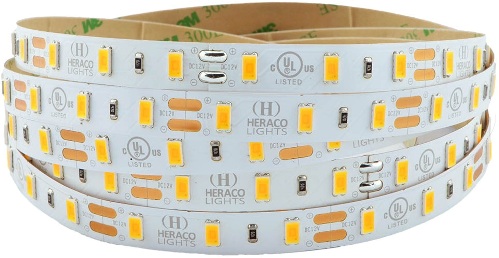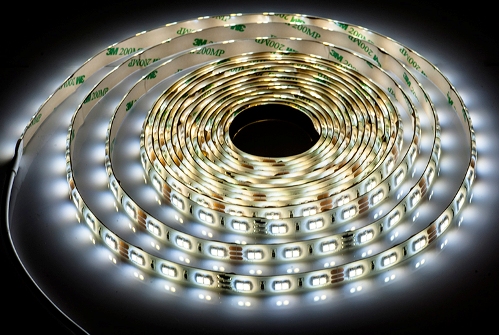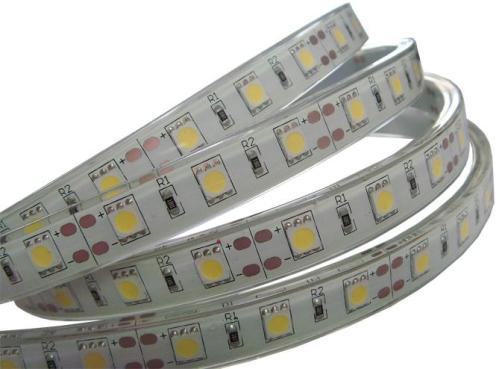Categories: Featured Articles » Sources of light
Number of views: 10,940
Comments on the article: 0
How to choose an LED strip
LED strip is one of the most popular solutions for the manufacture of decorative lighting or economical main lighting systems today. It can be the light in the apartment or the backlight in the car, the luminous strip under the ceiling or near the bookshelf, finally the festive decoration of the facade of the house or the New Year's lighting of the composition on the street - you can just decorate anything with LED tapes, you just need to choose these tapes correctly for this or that application.
In this article we will talk about choosing LED strips for various purposes, note important aspects of the choice, and warn the consumer against possible errors.
Monochrome or RGB tape

First, you need to decide if you need a single-color or multi-color LED strip. Monochrome ribbons shine in a specific color: red, orange, yellow, green, cyan, blue, violet or white. One tape - one color. Or another option - RGB tape, color tape.
No, this does not mean that several LEDs of different colors are installed on the tape, it means that special three-color LEDs are installed on the tape, each of which is capable in principle of giving any shade, depending on the power supply mode from RGB controller.
Such multi-color ribbons are well suited for the manufacture of iridescent decorative lighting of shelves, architectural compositions, ceilings in the bedroom or living room, in the car, etc. If you need to establish a general lighting system, then it is better to choose a single-color white tape (warm yellowish light for a bedroom or a cold bluish tint for a garage).
The choice of brightness and power
When the issue of choosing a color is resolved, the next step will be to determine the estimated brightness, and accordingly, the power of the tape. The determining factors here are: the size of the LEDs mounted on the tape, as well as the density of their installation along the length of the tape.

The following LED sizes are most popular: SMD5630 - for luminous flux of 18 Lm, SMD5050 - for 15 Lm, SMD3528 - for 5 Lm. The numbers after the letters “SMD” are, you guessed it, the size of each LED on the tape in tenths of a mm: for example, 5630 is 5.6 mm by 3.0 mm, etc. The larger the LED, the higher it is power.

And the denser the LEDs are installed on the tape - the higher the brightness of the tape, the higher will be the power of the light source thus obtained. Typical mounting densities are 30, 60, 72, 120, or 240 LEDs per meter of tape.
As for power, 15 watts per meter is usually enough to form a general lighting system, and here the smaller the LEDs - the denser they should be installed on the tape.
For example: SMD3528 with a density of 60 pieces per meter will produce about 300 Lm of luminous flux per meter of tape length, and from SMD5050 with a density of 30 pieces per square meter of tape, we get 450 Lm. The order of numbers is now clear.
Power Supply
Without a power supply, the LED strip will not work, so then you need to choose a power supply. Choosing power supply for led strip, come from the supply voltage and from the total power of the connected tapes. The rated power of the power supply should be taken with a margin of 10-20% compared with the total power of the connected tapes.

As for the tapes themselves, depending on the type of LEDs on the tape, and on their density on it, the power of the tape meter will turn out to be strictly defined.
Let's say you need 4 pieces of 2 meters of tape with single-color white SMD5050 LEDs, and with a density of LEDs of 120 pieces per meter of tape. The supply voltage for the tape is most often selected at 12 V DC.
A strip with LEDs of this size and with the named density consumes 25 watts per meter.Therefore, 4 pieces of 2 meters - this is 8 meters - 8 times 25 watts each, that is 200 watts.
So, with a margin of 20% in power, we will choose a network stabilized AC-DC power supply for a constant voltage of 12 V, with a power of 240 watts. And if it was a color ribbon? In this case, one would also have to choose an RGB controller for the appropriate power and the same supply voltage as the unit.
Tape quality
When calculations regarding the power and size of the tape are made, it’s up to you to buy the tape. And here the main thing is not to lose with the quality of the product. You should not chase the cheapness and immediately go to the Chinese trading Internet site.
In cheap tapes, wanting to get maximum brightness and light output, manufacturers put low-value resistors, for example, instead of the put 150 or 300 Ohms - only 100 Ohms. It is better if the resistors are of higher value.

In addition, the base of the tape should not be very soft - the conductive tracks will have to withstand the working current and not overheat.
Finally, mounting: LEDs should be installed on the tape exactly, not crooked. Better pay a little more, and then you can be sure of quality for many years. And it happens, you save - and you get a curve soldering and overheating. Miser pays twice.
Tape security

Where do I need to install this LED strip? Will she stand in the bathroom, where there is regularly high humidity, or is it intended for a dry living room, or maybe even for the street under the open sky? Here it is necessary to think about the degree of security of the tape.
Silicone or epoxy coating with a degree of protection of the sheath IP65, IP67, IP68 - will protect the tape from precipitation, moisture and dust - it is practically an analog of duralight. If the tape is placed on a shelf or in a cabinet, where it will always be dry and clean, then you can do the usual IP20 tape without a protective coating.
The same applies to the power supply. The power supply unit to ensure the light of the bathroom is installed either in a separate room, or its body must be protected from moisture.
See also on this topic: Features of connecting LED strips
See also at i.electricianexp.com
:
